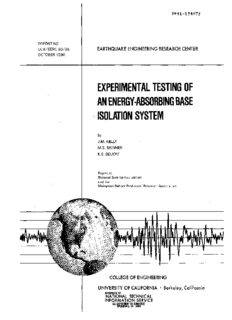Table Of ContentREPORT NO.
UCB/EERC-80/35 EARTHQUAKE ENGINEERING RESEARCH CENTER
OCTOBER 1980
EXPERIMENTAL TESTING OF
AN ENERGY-ABSORBING BASE
\ISOLATION SYSTEM
by
J.M. KELLY
M.S. SKINNER
K.E. BEUCKE
Reportto:
National Science Foundation
andthe
Malaysian Rubber Producers' Research Association
COLLEGE OF ENGINEERING
UNIVERSITY OF CALIFORNIA· Berkeley, California
REPROllUCEDBY
NATIONAL TECHNICAL
INFORMATION~£RVICE
u-s.DEPARTMEIiT'OECOMMERCE
SPllIIIGfIElD,VA 22161
DISCLAIMER
Any opinions, findings, and conclusions or
recommendationsexpressedinthispublica
tion are those of the authors and do not
necessarilyreflecttheviewsoftheSponsor
or the Earthquake Engineering Research
Center, Universityof California, Berkeley.
For sale by the National Technical Informa
tion Service, U.S. Department of Commerce,
Springfield, Virginia 22161.
See back of report for up to date listing of
EERC reports.
BIBLIOGRAPHIC DATA 11• Report No. r2. 3r. Recipient's Accession No.
SHEET NSF/RA-800297 PJ2? J- IS 4 0 7 2-
4. Title and Subtitle 5. Report Date
Experimental Testing of an Energy-Absorbing Bas.e Isolation October 1980
System
6.
7. Author(s} 8. Performing Organization Rept.
J. M. Kelly, M. S. Skinner, K. E. Beucke No. 80/35
9. Performing Organization Name and Address 10. Project/Task/Work Unit No.
Earthquake Engineering Research Center
University of California, Berkeley
11. Contracr/GrantNo.
Richmond Field Station
47th Street &Hoffman Blvd., Richmond,Calif\ 94804 PFR-7908257
12. Sponsoring OrganizationName and Addtess 13. Type of Report & Period
Covered
National Science Foundation
1800 GStreet, N.W.
Washington, D.C. 20550 14.
1S. Supplementary Notes
16. Absrracrs
The results of an experimental study of an aseismic base isolation system are
described in this report. Commercially produced natural rubber bearings and tapered
steel energy-absorbing devices are the primary components of the base isolation system.
The steel energy-absorbing devices span the natural rubber bearings and connect the
foundation to the base of the structure. Structural integrity under low-intensity
excitations, such as those produced by wind forces, is maintained since the cantilever
device remains stiff up to a predetermined level of loading. Once this,level-of loading
has been exceeded, the devices yield and the natural rubber bearing base isolation syster
operates to isolate the structure from the damaging effects of high-intensity ground
motion. Since the action of the energy.,.absorbing device is elastic-plastic, the
performance of the isolation system is enhanced by the introduction of considerable
hysteretic damping into the system upon yielding of the devices.
After the energy-absorbing device had been subjected to a series of preliminary
.static tests designed to determine the hysteretic- behavior of the device, the natural
rubber bearings and devices were incorporated in an 80,000 lb structural model. The
model was mounted on-a twenty-foot square shaking table and subjected to a ranqe of
earthquake ground motion. Relative displacements at the natural rubber bearings were
considerably lower with the devices installed, while structural accelerations were not
increased significantly. Reduction of the displacements at the bearings of an isolation
system such as that described here is necessary to ensure that the bearings remain
stable under load. When both the energy-absorbing device and natural rubber bearings
were in place, the structural model withstood simulated earthquake ground motions of
extremely high intensity.
18. Availability Statement 19.-Security Class (This 21.-No. of Pages
Report) 73
lJ'"Nrr A"<::Il"TEn
Release Unlimited
20. Secutity Class (This 22. Price
Page
UNCLASSIFIED
FORM NTI5-35 (REV. 10-731 ENDORSED BY ANSI A..'i'D UNESCO. THIS FORMMAY BE REPRODUCED USCOMM·OC 8211S·P74
EXPERIMENTAL TESTING OF AN ENERGY-ABSORBING
BASE ISOLATION SYSTEM
by
James M. Kelly
Professor of Civil Engineering
Department of Civil Engineering
University of California
Berkeley, California
and
Mark S. Skinner &Karl E. Beucke
Graduate Students
Division of Structural Engineering & Structural Mechanics
Department of Civil Engineering
University of California
Berkeley, California
Report No. UCB/EERC-80/35
Earthquake Engineering Research Center
College of Engineering
University of California
Berkeley, California
October 1980
- i -
ABSTRACT
The results of an experimental study of an aseismic base isolation system are
described in this report. Commercially produced natural rubber bearings and tapered
steel energy-absorbing devices are the primary components ofthe base isolation system.
The steel energy-absorbing devices span the natural rubber bearings and connect the
foundation to the base of the structure. Structural integrity under low-intensity excita
tions, such as those produced by wind forces, is maintained since the cantilever device
remains stiff up to a predetermined level of loading. Once this level of loading has
been exceeded, the devices yield and the natural rubber bearing base isolation system
operates to isolate the structure from the damaging effects of high-intensity ground
motion. Since the action of the energy-absorbing device is elastic-plastic, the perfor
mance ofthe isolation system is enhanced by the introduction ofconsiderable hysteretic
damping into the system upon yielding ofthe devices.
After the energy-absorbing device had been subjected to a series of preliminary
static tests designed to determine the hysteretic behavior of the device, the natural
rubber bearings and devices were incorporated in an 80,000 lb structural model. The
model was mounted on a twenty-foot square shaking table and subjected to a range of
earthquake ground motion. Relative displacements at the natural rubber bearings were
considerably lower with the devices installed, while structural accelerations were not
increased significantly. Reduction of the displacements at the bearings of an isolation
system such as that described here is necessary to ensure that the bearings remain
stable under load. When both the energy-absorbing device and natural rubber bearings
were in place, the structural model withstood simulated earthquake ground motions of
extremely high intensity.
- iii - Preceding page blank
ACKNOWLEDGMENTS
The research reported herein was supported by the National Science Foundation
under Grant No. PFR-7908257 and by the Malaysian Rubber Producers' Research
Association, which support is gratefully acknowledged. The Andre Rubber Company,
Ltd. provided the bearings used in the tests.
Description:Sponsoring Organization Name and Addtess . sion, for helicopter rotors [5] and for wharf fenders [6] ple schematic diagram of the experimental arrangement is given in Figure 3 and a photograph . are analogue displacement time histories on magnetic tape, normally obtained through a double.

